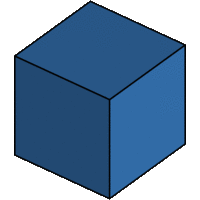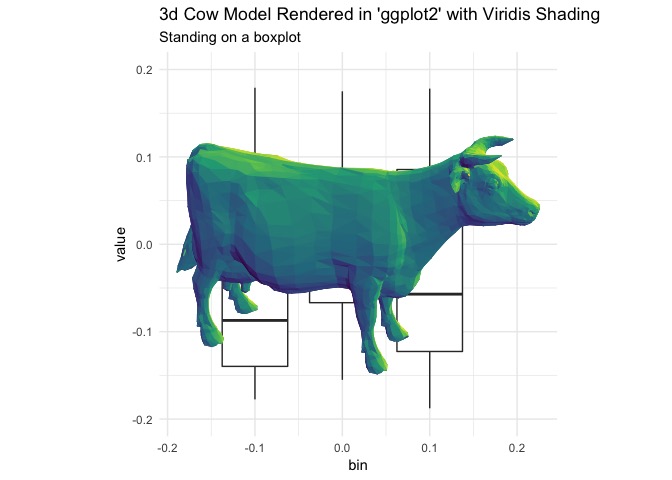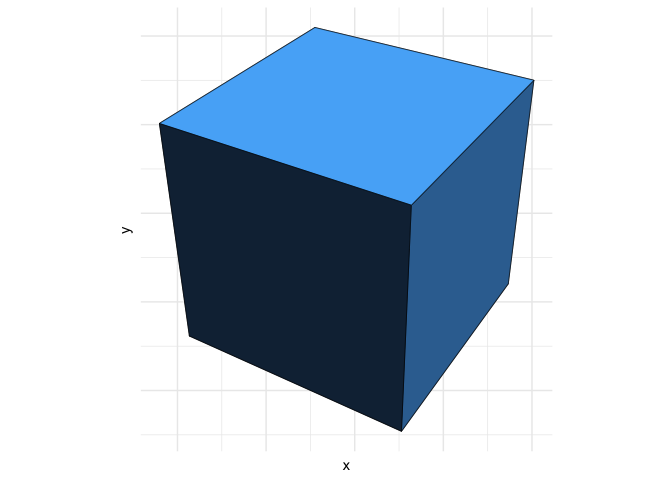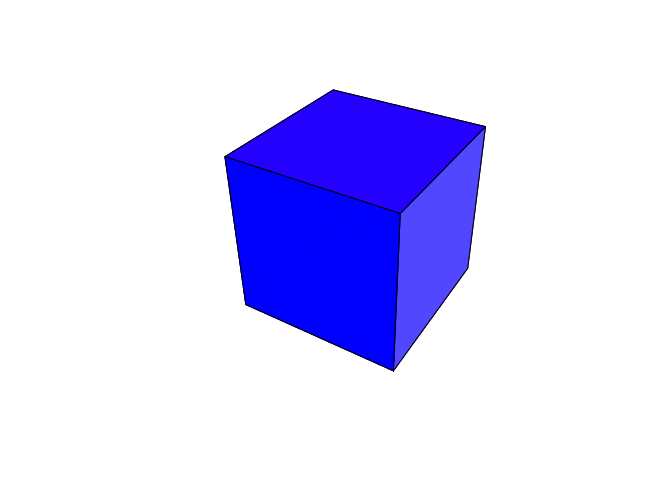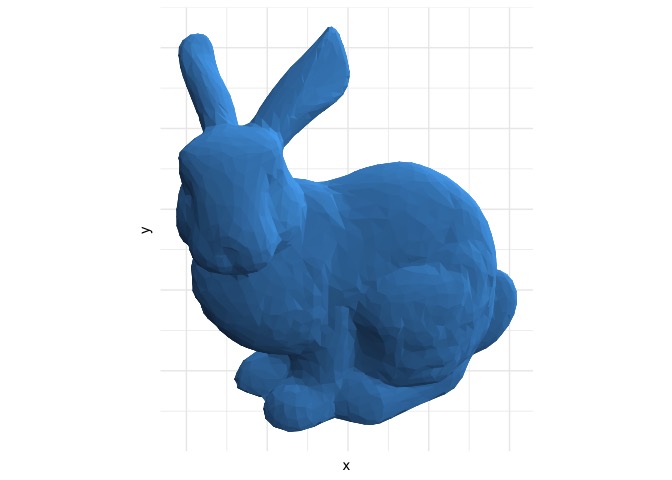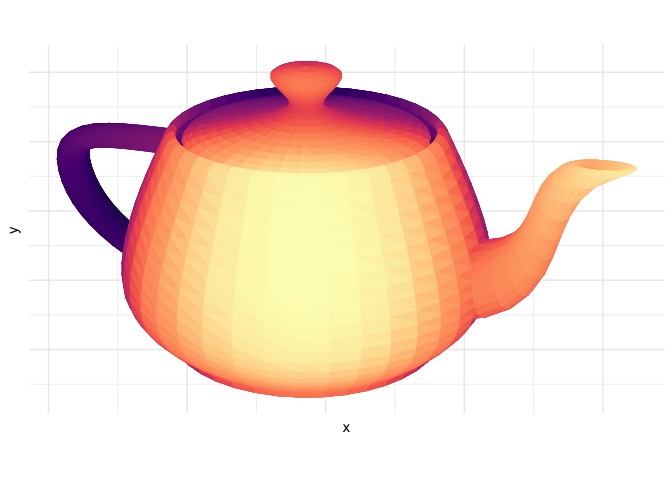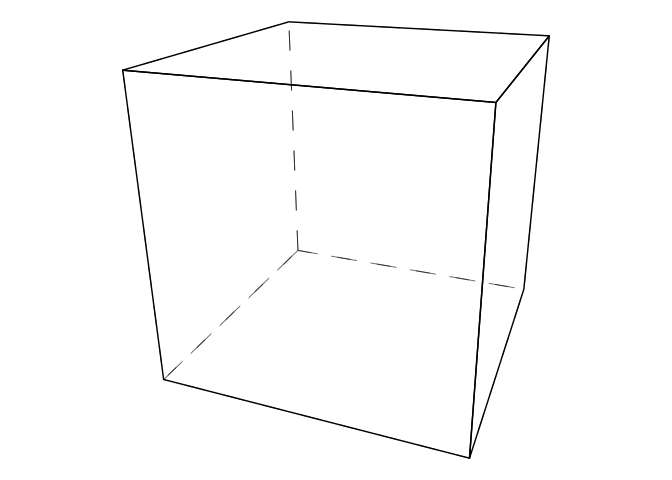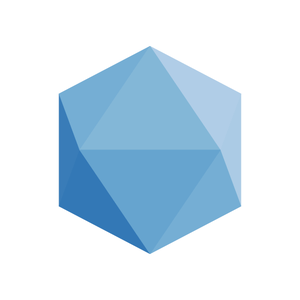threed is a small, dependency-free R library for doing 3d object
transformations i.e. translation, scaling, rotation and perspective
projection.
The only 3d object format currently supported is the mesh3d format
from rgl (as well as some extensions to the mesh3d format to support
point and line objects).
- standard translate, scale and rotate transformations
- perspective + orthographic projection
as.data.frame.mesh3d- convert 3d objects into data.frames
- calculates a lot of meta data such as face normals, vertex normals and whether a face is hidden from view.
fortify.mesh3d- this enables a
mesh3dobject to be given as the ggplot2dataargument.
- this enables a
- Includes some built-in
mesh3dobjects (seethreed::mesh3dobj) e.g.cube,icosahedron,teapot,cow,bunny
vignette('drawing-a-cube', package='threed')- All the ways of drawing a 3d cube using
threedinggplot2 - e.g. hidden line removal, fake light shading etc
- All the ways of drawing a 3d cube using
vignette('mesh3d', package='threed')- Adaptations and extensions to the
mesh3dformat
- Adaptations and extensions to the
vignette('animate-in-3d', package='threed')- Creating a simple 3d animated object in
ggplot2
- Creating a simple 3d animated object in
threedis just a 3d object transformation package and does not include any facility for rendering of objects.- Examples are included below showing how to convert 3d objects to a
data.frame and then render with:
ggplot2andgeom_polygon()- Base R plotting with
polygon()
# install.packages("devtools")
devtools::install_github("coolbutuseless/threed")A mesh3d object can be converted to a data.frame representation using
threed::as.data.frame.mesh3d().
Besides the standard x,y,z coordinates, the data.frame also includes:
element_ididentifier for each elementelement_typeindicating how many vertices in an elementvorderthe ordering of the vertices to define each element- normal at each vertex -
vnx, vny, vnz - normal of each face -
fnx, fny, fnz - centroid of each face =
fcx, fcy, fcz vertexglobal vertex identifier from themesh3dobjectzorderthe drawing order of the elements from back to fronthiddenwhether or not the face is hidden. i.e.fnz < 0
#~~~~~~~~~~~~~~~~~~~~~~~~~~~~~~~~~~~~~~~~~~~~~~~~~~~~~~~~~~~~~~~~~~~~~~~~~~~~~
# Convert the object from mesh3d to a data.frame
#~~~~~~~~~~~~~~~~~~~~~~~~~~~~~~~~~~~~~~~~~~~~~~~~~~~~~~~~~~~~~~~~~~~~~~~~~~~~~
threed::mesh3dobj$cube %>%
as.data.frame() %>%
head() %>%
knitr::kable(caption = "First few rows of the mesh3d cube after conversion to a data.frame")| element_id | element_type | vorder | x | y | z | vertex | vnx | vny | vnz | fnx | fny | fnz | fcx | fcy | fcz | zorder | zorder_var | hidden |
|---|---|---|---|---|---|---|---|---|---|---|---|---|---|---|---|---|---|---|
| 1 | 4 | 1 | -1 | -1 | -1 | 1 | -0.5773503 | -0.5773503 | -0.5773503 | 0 | 0 | -1 | 0 | 0 | -1 | 1 | -1 | TRUE |
| 1 | 4 | 2 | -1 | 1 | -1 | 3 | -0.5773503 | 0.5773503 | -0.5773503 | 0 | 0 | -1 | 0 | 0 | -1 | 1 | -1 | TRUE |
| 1 | 4 | 3 | 1 | 1 | -1 | 4 | 0.5773503 | 0.5773503 | -0.5773503 | 0 | 0 | -1 | 0 | 0 | -1 | 1 | -1 | TRUE |
| 1 | 4 | 4 | 1 | -1 | -1 | 2 | 0.5773503 | -0.5773503 | -0.5773503 | 0 | 0 | -1 | 0 | 0 | -1 | 1 | -1 | TRUE |
| 2 | 4 | 1 | -1 | 1 | -1 | 3 | -0.5773503 | 0.5773503 | -0.5773503 | 0 | 1 | 0 | 0 | 1 | 0 | 2 | 0 | FALSE |
| 2 | 4 | 2 | -1 | 1 | 1 | 7 | -0.5773503 | 0.5773503 | 0.5773503 | 0 | 1 | 0 | 0 | 1 | 0 | 2 | 0 | FALSE |
First few rows of the mesh3d cube after conversion to a data.frame
#~~~~~~~~~~~~~~~~~~~~~~~~~~~~~~~~~~~~~~~~~~~~~~~~~~~~~~~~~~~~~~~~~~~~~~~~~~~~~
# Define camera position and what it's looking at.
# Use the inverse of this to transform all objects in the world
#~~~~~~~~~~~~~~~~~~~~~~~~~~~~~~~~~~~~~~~~~~~~~~~~~~~~~~~~~~~~~~~~~~~~~~~~~~~~~
camera_to_world <- threed::look_at_matrix(eye = c(3, 4, 5), at = c(0, 0, 0))
#~~~~~~~~~~~~~~~~~~~~~~~~~~~~~~~~~~~~~~~~~~~~~~~~~~~~~~~~~~~~~~~~~~~~~~~~~~~~~
# - take a cube object
# - position it in the camera view
# - perform perspective projection
#~~~~~~~~~~~~~~~~~~~~~~~~~~~~~~~~~~~~~~~~~~~~~~~~~~~~~~~~~~~~~~~~~~~~~~~~~~~~~
obj <- threed::mesh3dobj$cube %>%
transform_by(invert_matrix(camera_to_world)) %>%
perspective_projection()
#~~~~~~~~~~~~~~~~~~~~~~~~~~~~~~~~~~~~~~~~~~~~~~~~~~~~~~~~~~~~~~~~~~~~~~~~~~~~~
# Use ggplot to plot the obj
#~~~~~~~~~~~~~~~~~~~~~~~~~~~~~~~~~~~~~~~~~~~~~~~~~~~~~~~~~~~~~~~~~~~~~~~~~~~~~
ggplot(obj) +
geom_polygon(aes(x = x, y = y, group = zorder, fill = 0.5 * fnx + fny), colour = 'black', size = 0.2) +
theme_minimal() +
theme(
legend.position = 'none',
axis.text = element_blank()
) +
coord_equal() #~~~~~~~~~~~~~~~~~~~~~~~~~~~~~~~~~~~~~~~~~~~~~~~~~~~~~~~~~~~~~~~~~~~~~~~~~~~~~
# Explicitly convert to data.frame
#~~~~~~~~~~~~~~~~~~~~~~~~~~~~~~~~~~~~~~~~~~~~~~~~~~~~~~~~~~~~~~~~~~~~~~~~~~~~~
obj_df <- as.data.frame(obj)
#~~~~~~~~~~~~~~~~~~~~~~~~~~~~~~~~~~~~~~~~~~~~~~~~~~~~~~~~~~~~~~~~~~~~~~~~~~~~~
# Set up a palette - one entry for each face
#~~~~~~~~~~~~~~~~~~~~~~~~~~~~~~~~~~~~~~~~~~~~~~~~~~~~~~~~~~~~~~~~~~~~~~~~~~~~~
pal <- colorRampPalette(c('white', 'blue'))(6)
#~~~~~~~~~~~~~~~~~~~~~~~~~~~~~~~~~~~~~~~~~~~~~~~~~~~~~~~~~~~~~~~~~~~~~~~~~~~~~
# Initialise a plot of the correct size
#~~~~~~~~~~~~~~~~~~~~~~~~~~~~~~~~~~~~~~~~~~~~~~~~~~~~~~~~~~~~~~~~~~~~~~~~~~~~~
with(obj_df, plot(x, y, asp = 1, type = 'p', pch = '.', ann = FALSE, axes = FALSE))
#~~~~~~~~~~~~~~~~~~~~~~~~~~~~~~~~~~~~~~~~~~~~~~~~~~~~~~~~~~~~~~~~~~~~~~~~~~~~~
# For each element_id, draw polygons
#~~~~~~~~~~~~~~~~~~~~~~~~~~~~~~~~~~~~~~~~~~~~~~~~~~~~~~~~~~~~~~~~~~~~~~~~~~~~~
obj_df %>%
split(., .$zorder) %>%
purrr::walk(
~with(.x, polygon(x, y, col = pal[zorder], density = 300, border = 'black'))
)camera_to_world <- look_at_matrix(eye = c(-1.5, 1.75, 4), at = c(0, 0, 0))
obj <- threed::mesh3dobj$bunny %>%
transform_by(invert_matrix(camera_to_world)) %>%
perspective_projection()
ggplot(obj, aes(x, y, group = element_id)) +
geom_polygon(aes(fill = fnx + fny, colour = fnx + fny, group = zorder)) +
theme_minimal() +
theme(
legend.position = 'none',
axis.text = element_blank()
) +
coord_equal() camera_to_world <- look_at_matrix(eye = c(1.5, 1.75, 4), at = c(0, 0, 0))
obj <- threed::mesh3dobj$teapot %>%
transform_by(invert_matrix(camera_to_world)) %>%
perspective_projection()
ggplot(obj, aes(x, y, group = zorder)) +
geom_polygon(aes(fill = zorder, colour = zorder)) +
theme_minimal() +
theme(
legend.position = 'none',
axis.text = element_blank()
) +
coord_equal() +
scale_fill_viridis_d (option = 'A') +
scale_color_viridis_d(option = 'A')Dashed hidden lines
camera_to_world <- look_at_matrix(eye = c(1.5, 1.75, 4), at = c(0, 0, 0))
obj <- threed::mesh3dobj$cube %>%
transform_by(invert_matrix(camera_to_world)) %>%
perspective_projection()
ggplot(obj, aes(x, y, group = element_id)) +
geom_polygon(fill = NA, colour='black', aes(linetype = hidden, size = hidden)) +
scale_linetype_manual(values = c('TRUE' = "FF", 'FALSE' = 'solid')) +
scale_size_manual(values = c('TRUE' = 0.2, 'FALSE' = 0.5)) +
theme_void() +
theme(legend.position = 'none') +
coord_equal()See vignette('animate-in-3d', package='threed')
threed is used to generate its own hex logo by rendering an
orthographic projection of a cube.
camera_to_world <- look_at_matrix(eye = c(4, 4, 4), at = c(0, 0, 0))
#~~~~~~~~~~~~~~~~~~~~~~~~~~~~~~~~~~~~~~~~~~~~~~~~~~~~~~~~~~~~~~~~~~~~~~~~~~~~~~
# Ensure the output directory is tidy
#~~~~~~~~~~~~~~~~~~~~~~~~~~~~~~~~~~~~~~~~~~~~~~~~~~~~~~~~~~~~~~~~~~~~~~~~~~~~~~
png_files = list.files("~/gganim", "logo.*png", full.names = TRUE)
unlink(png_files)
#~~~~~~~~~~~~~~~~~~~~~~~~~~~~~~~~~~~~~~~~~~~~~~~~~~~~~~~~~~~~~~~~~~~~~~~~~~~~~~
# Render a cube at a range of angles. Use orthographic projection
#~~~~~~~~~~~~~~~~~~~~~~~~~~~~~~~~~~~~~~~~~~~~~~~~~~~~~~~~~~~~~~~~~~~~~~~~~~~~~~
angles <- tail(seq(0, pi/2, length.out = 15), -1)
for (i in seq_along(angles)) {
obj <- threed::mesh3dobj$cube %>%
rotate_by(angle = angles[i], v = c(0, 1, 0)) %>%
transform_by(invert_matrix(camera_to_world)) %>%
orthographic_projection()
p <- ggplot(obj, aes(x, y, group = zorder)) +
geom_polygon(aes(fill = fnx), colour='black') +
theme_void() +
theme(legend.position = 'none') +
coord_equal(xlim = c(-1.5, 1.5), ylim = c(-1.5, 1.5)) +
scale_fill_continuous(limits = c(-1, 1))
ggsave(sprintf("~/gganim/logo-%03i.png", i), plot = p, width = 2, height = 2)
}
#~~~~~~~~~~~~~~~~~~~~~~~~~~~~~~~~~~~~~~~~~~~~~~~~~~~~~~~~~~~~~~~~~~~~~~~~~~~~~~
# Set background to be transparent, and create an animated gif
# Doing this manually in imagemagick to avoid aretfacts that gifski added,
# and to set a longer delay between loops
#~~~~~~~~~~~~~~~~~~~~~~~~~~~~~~~~~~~~~~~~~~~~~~~~~~~~~~~~~~~~~~~~~~~~~~~~~~~~~~
system("mogrify -transparent white ~/gganim/logo*.png")
system("convert -delay 0 -loop 0 -dispose previous -resize 200x200 ~/gganim/logo*.png figures/logo.gif")
system("convert figures/logo.gif \\( +clone -set delay 500 \\) +swap +delete figures/logo-with-pause.gif")